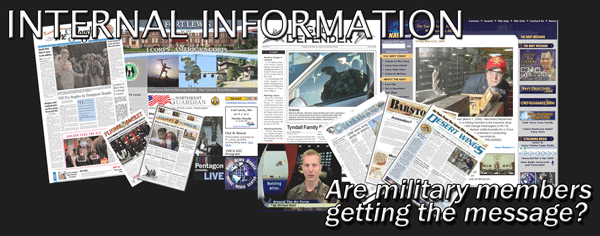The purpose of this study was to measure the level of exposure and use of various forms of internal active duty military information as opposed to other modes of civilian communication.
Participants
Participants were active military personnel from all branches and bases (N=332). Service participation breaks down as follows: Air Force: 261, Navy: 63, Army: 5, and Marine Corps: 3. Officer: 13.3 percent, E-5 and above: 56.6 percent, and E-4 and below: 30.1 percent. Male: 259, and female: 73.
Procedure
Public Affairs professionals from each branch of service received information promoting the study. The news release encouraged active duty military personnel to take part in the study in order to determine the value of base newspapers. This was a random sample in that it provided everyone with an equal opportunity to participate if they wanted to.
Participants in this study were directed to a web site where the questionnaire was posted. Only active duty military personnel could log on to the site and fill out the questionnaire.
The questionnaire was posted on SurveyMonkey.com. Survey Monkey is an unaffiliated, civilian website service based in Portland, OR, that provides templates for designing surveys. This subscription-based service is used by a variety of business and education professionals. This research project used Survey Monkey to collect, sort and export data from respondents. It was deemed appropriate to only place the questionnaire online because it is a standard practice for the military branches to frequently distribute questionnaires via official websites such as Navy Knowledge Online. The questionnaire took about 10 minutes for respondents to complete.
Gratifications
Uses and gratifications was assessed for base newspapers, base internal websites, commander’s access television channel, and the prospect of an online base newspaper using the Palmgreen, Wenner, Rayborn (1980) scale of uses and gratifications. The measure has five dimensions which are assessed using seven-point Likert-type scales with a zero option (does not/does apply to me). The five dimensions were: general information seeking, consisting of the items: I use [communication form] to keep up with current news and issues, I use [communication form] to learn about military policies and procedures, and I use [communication form] because you can trust the information that they give you; decision utility, consisting of:
I use [communication form] to find out what kind of job our government officials are doing, I use [communication form] to help me learn things relevant to my job, and I use [communication form] to find out about my co-workers; entertainment, consisting of: I use [communication form] because it is often entertaining, I use [communication form] because they are often dramatic, and I use [communication form] because they are exciting; interpersonal utility, consisting of: I use [communication form] so I can support my own viewpoints to other people, I use [communication form] so I can pass the information on to other people, and I use [communication form] to give me interesting things to talk about; and parasocial interaction, consisting of: I use [communication form] because the writers give a human quality to the news, I use [communication form] to compare my own ideas to what the persons in the newspaper are saying, and I use [communication form] because the sources in the newspaper are like other people I know.
Alpha reliabilities of the measures were: general information seeking, a=.81-.94; decision utility, a=.76-.93; entertainment, a=.81-.95; interpersonal utility, a=.78-.94; and parasocial interaction, a=.87-.96.
Communicator Use
Media use was operationalized as exposure to and attention paid to specific communication media. The investigation employed two ten-point scales to assess people’s exposure to and attention paid to given media sources. This approach is recommended by McLeod & McDonald, (1985) and Chaffee & Schleuder (1986) who maintain that both exposure and attention scales are required in order to compare communication use of news media forms. The measures are specific in their operationalizations of media use. The exposure scale ranges from “rarely use” to “frequently use;” the attention scale ranged from “no attention” to “close attention.” Specific communication forms included: national television news programs (e.g., CBS, ABC, NBC), local television news programs, newspapers, base newspapers, magazines (e.g., Time, Newsweek), online military magazines, print military magazines, radio talk shows (e. g., Rush Limbaugh), radio news programs, television talk shows, television entertainment talk shows (e.g., Letterman), television news magazines (e.g., 60 Minutes, 20/20), prime time television shows (e. g., Commander in Chief or NCIS), the world wide web, base web sites, and conversations with others.
Attitude
Overall attitude about base newspapers was assessed with a global attitude measure adapted from Burgoon, Cohen, Miller, and Montgomery (1978). The measure’s seven-point bipolar adjective scale includes: unacceptable/acceptable, foolish/wise, unfavorable/favorable, negative/positive, bad/good, and wrong/right. The overall attitude was positive (a=.86).
BACK TO TOP
